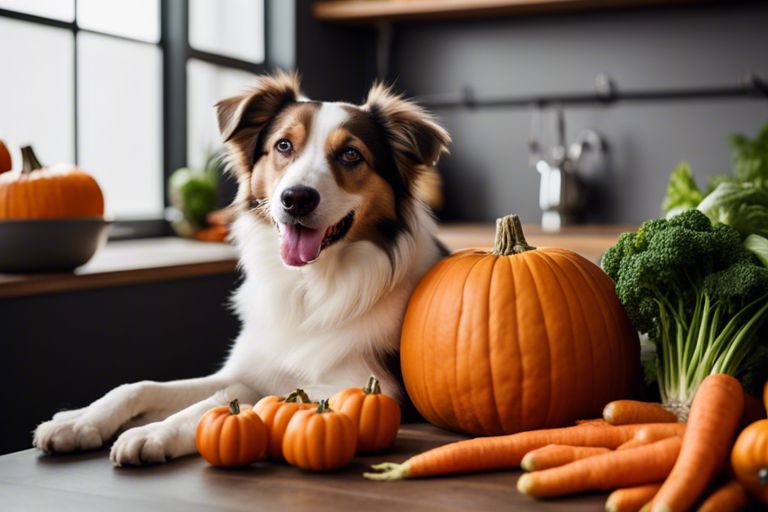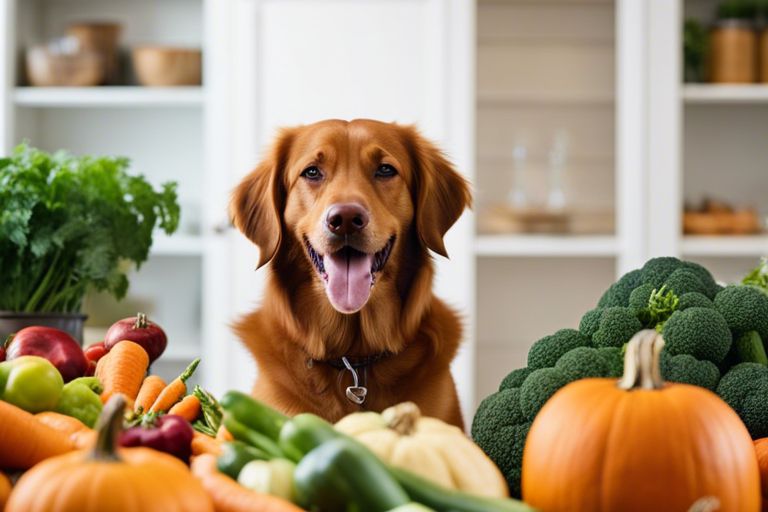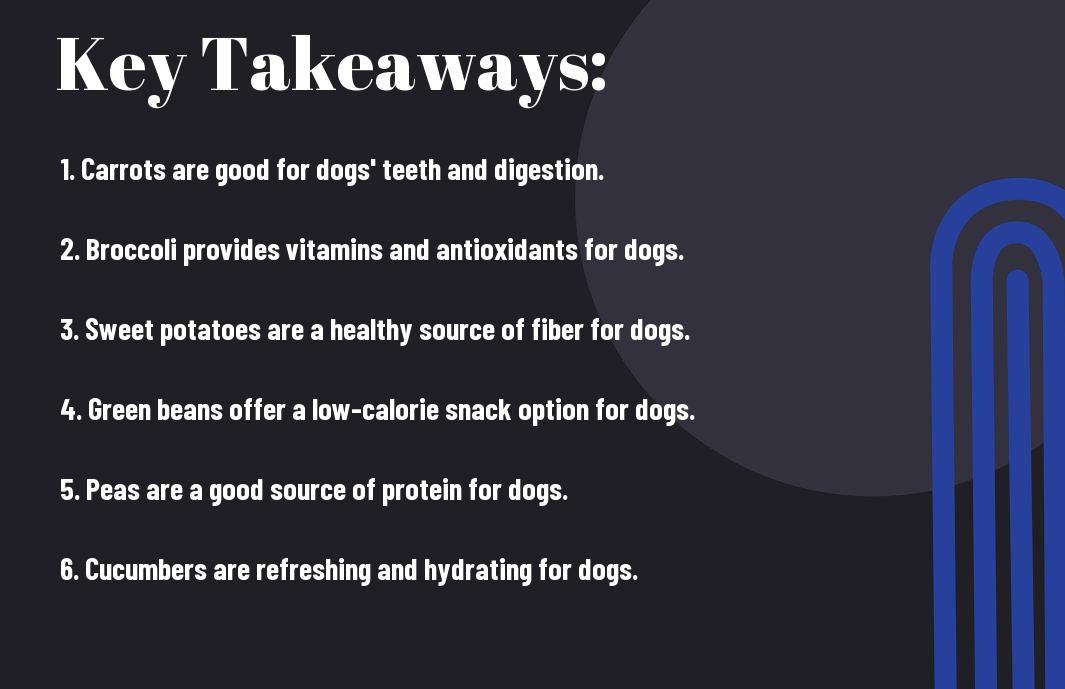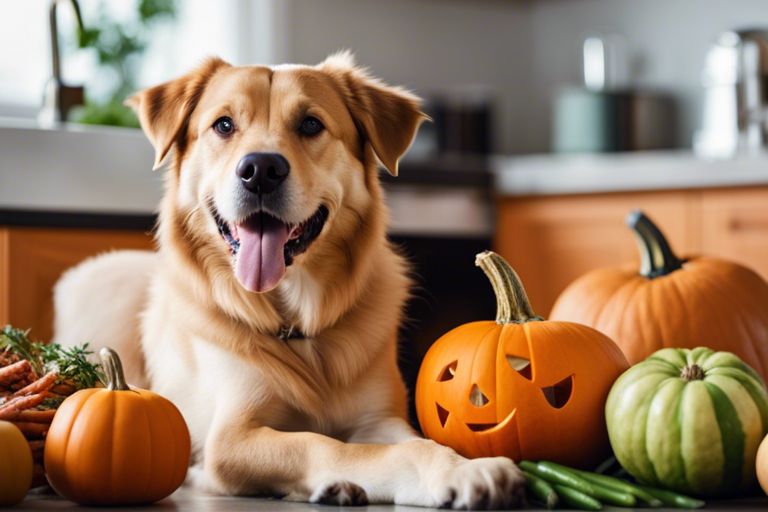With a wag of their tail and a bark that’s sweet, you might be wondering which veggies make a great doggy treat. Not all vegetables are safe for your furry friend, but fear not, here’s a list that will help you to no end. Carrots, green beans, and sweet potatoes too, are some examples of veggies that are healthy and good for your doggy to chew. Just remember to always introduce new foods with care, and soon you’ll have a happy and healthy pooch with flair!
Key Takeaways:
- Dogs can safely eat certain vegetables: Some vegetables are not only safe for dogs to eat but can also provide a range of health benefits.
- Vegetables to avoid: While many vegetables are safe for dogs, some can be harmful or toxic to them. It’s vital to be cautious and avoid feeding your furry friend these veggies.
- Always consult with a veterinarian: Before introducing new vegetables into your dog’s diet, it’s important to consult with a veterinarian to ensure they are safe and appropriate for your pet’s health and dietary needs.
Canine Cuisine Basics
Why Vegetables Matter for Dogs
Before you start adding vegetables to your dog’s diet, it’s imperative to understand why they are important. Just like humans, dogs can benefit from a variety of nutrients found in vegetables. Incorporating vegetables into your dog’s meals can provide them with imperative vitamins, minerals, and fiber that contribute to their overall health and well-being.
Nutritional Benefits of Veggies for Dogs
With dogs being omnivores, they can consume a balanced diet that includes vegetables alongside their regular food. Vegetables offer a range of nutritional benefits for your furry friend, such as being a good source of vitamins like A, C, and K, as well as minerals like potassium and folate. Additionally, the fiber content in vegetables can aid in digestion and contribute to your dog’s digestive health.
Dogs may not be able to digest certain vegetables as efficiently as humans due to their shorter digestive system. To make the most out of the nutritional benefits of veggies for your dog, it’s recommended to steam or lightly cook vegetables before serving them. This can help break down tough cell walls and make the nutrients more accessible for your pup to absorb.
The Safe Zone
While there are many vegetables that dogs can safely enjoy, it’s vital to stick to those in the “safe zone” to avoid any tummy troubles or health issues for your furry friend.
Leafy Greens for Dogs
Leafy greens such as spinach, kale, and lettuce can be a nutritious addition to your dog’s diet. These greens are packed with vitamins and minerals that can benefit your pup’s overall health. Just be sure to chop them up into bite-sized pieces to prevent choking hazards.
Cruciferous Delights for Canines
Any pup can gobble up cruciferous vegetables like broccoli, cauliflower, and Brussels sprouts. These veggies are not only tasty but also provide a good source of fiber and antioxidants for your dog. However, be cautious not to overfeed them, as large quantities can lead to digestive issues.
Cruciferous vegetables are best served cooked to aid in digestion and nutrient absorption.
Root Vegetables for a Healthy Coat
An assortment of root vegetables such as carrots, sweet potatoes, and beets can help promote a healthy and shiny coat for your furry companion. These vegetables are rich in beta-carotene, which converts to vitamin A, a crucial nutrient for skin and coat health. Just remember to cook them thoroughly to avoid any possible choking hazards.
Root vegetables are a great alternative to store-bought treats and can serve as a healthy snack option for your dog.
The Caution Zone
One
Vegetables to Approach with Caution
Once again, while many vegetables are safe for your furry friend to enjoy, there are some that should be approached with caution. Vegetables like onions, garlic, and chives can be toxic to dogs and should be avoided. These vegetables can cause damage to your dog’s red blood cells, leading to potential health issues.
Common Allergens and Intolerances
For dogs, just like humans, there are common allergens and intolerances when it comes to vegetables. Some dogs may have sensitivities to vegetables like bell peppers, tomatoes, or certain types of squashes. It’s crucial to monitor your dog after introducing a new vegetable into their diet to watch out for any signs of allergies or intolerances.
Allergens can present themselves in various ways, such as itching, digestive issues, or even respiratory problems. If you notice any unusual symptoms after giving your dog a new vegetable, it’s best to consult your veterinarian for guidance.
Cooking and Preparation Tips
Preparation:
- Always wash vegetables thoroughly to remove any pesticides or harmful bacteria.
- Remove seeds, pits, and any parts that could be a choking hazard for your dog.
Recognizing these precautions can help ensure that your dog enjoys vegetables safely as part of their diet.
It’s crucial to remember that every dog is different, and what works for one pup may not work for another. By introducing new vegetables slowly and carefully monitoring your dog’s reaction, you can safely incorporate a variety of healthy vegetables into their meals.
The Danger Zone
Many vegetables are safe for dogs to eat, but there are some that fall into the danger zone and should be avoided at all costs. It’s important to be aware of the toxic vegetables that can be harmful to your furry friend.
Toxic Vegetables to Avoid
Zone in on vegetables like onions, garlic, and chives, as they can cause severe toxicity in dogs. These vegetables can lead to symptoms such as vomiting, diarrhea, weakness, and even damage to red blood cells. Make sure to keep these dangerous veggies out of your dog’s reach.
Common Mistakes Dog Owners Make
Mistakes happen, but when it comes to your dog’s health, it’s crucial to be careful. Some common mistakes dog owners make include assuming all vegetables are safe for dogs and not checking for poisonous vegetables before sharing them with their pets. Bear in mind, what’s healthy for you may not be safe for your furry companion.
Avoid putting your dog at risk by thoroughly researching which vegetables are safe for them to consume. It’s always better to be safe than sorry when it comes to your dog’s well-being.
Signs of Vegetable Poisoning in Dogs
Signs that your dog may have consumed a toxic vegetable include vomiting, diarrhea, abdominal pain, drooling, lethargy, and more. If you notice any of these symptoms after your dog has ingested a vegetable, contact your veterinarian immediately for guidance.
Make sure to monitor your dog closely after they have eaten any vegetables and seek professional help if you suspect any signs of vegetable poisoning. Your quick action could make a significant difference in your dog’s recovery.
Veggie Treats and Snacks
All 14 Vegetables Dogs Can Eat (And May Just Love) provide a great opportunity for healthy and tasty treats for your furry friend. From crunchy carrots to tender green beans, these veggies can make excellent snacks that your dog will enjoy.
Healthy Snacking Options for Dogs
To ensure your dog gets the best of these veggie treats, it’s important to offer them in bite-sized pieces that are easy for your pup to munch on. You can also try steaming or lightly cooking some vegetables to make them more palatable and easier to digest for your canine companion.
Homemade Treat Recipes
Healthy homemade treats can be a fun way to incorporate veggies into your dog’s diet. You can create tasty snacks by mixing pureed vegetables like sweet potatoes or green peas with a bit of flour and water, then baking them into bite-sized treats. This way, you control the ingredients and ensure your pup gets a healthy snack.
A variety of recipes for homemade veggie dog treats can be found online, allowing you to experiment and find the perfect snack that your dog will love.
Store-Bought Options to Consider
For snacking on the go or when you’re short on time, consider looking for store-bought veggie treats for your dog. Many pet stores offer a wide range of options, from dehydrated sweet potato chips to frozen vegetable mixes specially designed for dogs.
For convenience and variety, store-bought veggie snacks can be a great addition to your dog’s diet. Just remember to check the ingredients and choose treats that are safe and healthy for your furry companion.
Snacking on veggies can be a fun and nutritious way to treat your dog while providing important vitamins and minerals. Whether you opt for homemade creations or convenient store-bought options, adding vegetables to your dog’s snack menu can be a great way to keep them healthy and happy.
Feeding Guidelines
How Much is Too Much?
One important thing to keep in mind when feeding your dog vegetables is moderation. While vegetables can be a healthy addition to your dog’s diet, feeding them too many can lead to an upset stomach or digestive issues. It is recommended to introduce new vegetables gradually and monitor your dog’s reaction to them. Consulting with your vet can also help you determine the right amount of vegetables to include in your dog’s diet.
Balancing Vegetables with Meat and Grains
One key aspect to consider when feeding your dog vegetables is to ensure a well-balanced diet. While vegetables provide imperative nutrients and vitamins, they should not replace meat and grains in your dog’s diet. Meat is a primary source of protein for dogs, and grains offer important carbohydrates. By combining vegetables with meat and grains, you can ensure that your dog receives a complete and balanced diet.
Vegetables: When adding vegetables to your dog’s diet, it’s crucial to consider the nutritional value they bring. Different vegetables offer various vitamins and minerals, so incorporating a variety of vegetables can help meet your dog’s nutritional needs. Some vegetables, like carrots and green beans, are popular choices among dogs and are easy to digest.
Age and Breed-Specific Considerations
Much like humans, age and breed can also impact the dietary needs of dogs. Puppies, adult dogs, and senior dogs have different nutritional requirements. Likewise, certain breeds may have specific dietary sensitivities or preferences. Consulting with your vet can help you tailor your dog’s diet to their age and breed, ensuring they receive the right balance of nutrients.
Considerations: When choosing vegetables for your dog, consider their individual needs and preferences. Some dogs may have allergies or sensitivities to certain vegetables, so it’s imperative to introduce new foods gradually and monitor their reaction. Additionally, incorporating a variety of vegetables in your dog’s diet can help prevent nutrient deficiencies and keep them healthy and happy.
To wrap up
Conclusively, when it comes to feeding your furry friend vegetables, stay away from toxic ones like onions and garlic, and try to feed them in moderation. Do not forget, every dog is different, and what might work for one might not work for another. It’s always best to consult with your veterinarian before introducing new foods into your dog’s diet. With a little bit of knowledge and care, you can provide your canine companion with a healthy and balanced diet that includes some tasty veggies!
FAQ
Q: Can dogs eat carrots?
A: Dogs can eat carrots, oh so sweet! Just make sure they’re cut up neat.
Q: Are peas safe for dogs to munch?
A: Peas are fine for dogs to eat, a healthy treat, oh so neat!
Q: What about broccoli, can dogs have it too?
A: Broccoli for dogs is okay, but in small amounts, let them play.
Q: Can dogs gobble up some spinach leaves?
A: Spinach for dogs is safe to chew, but too much may not be good for their view.
Q: How about sweet potatoes, are they fine?
A: Sweet potatoes for dogs are a delight, just cook them right, oh what a sight!
Are strawberries toxic for dogs
Demystifying Anal Gland Issues in Dogs: Your Comprehensive Guide from the American Kennel Club




